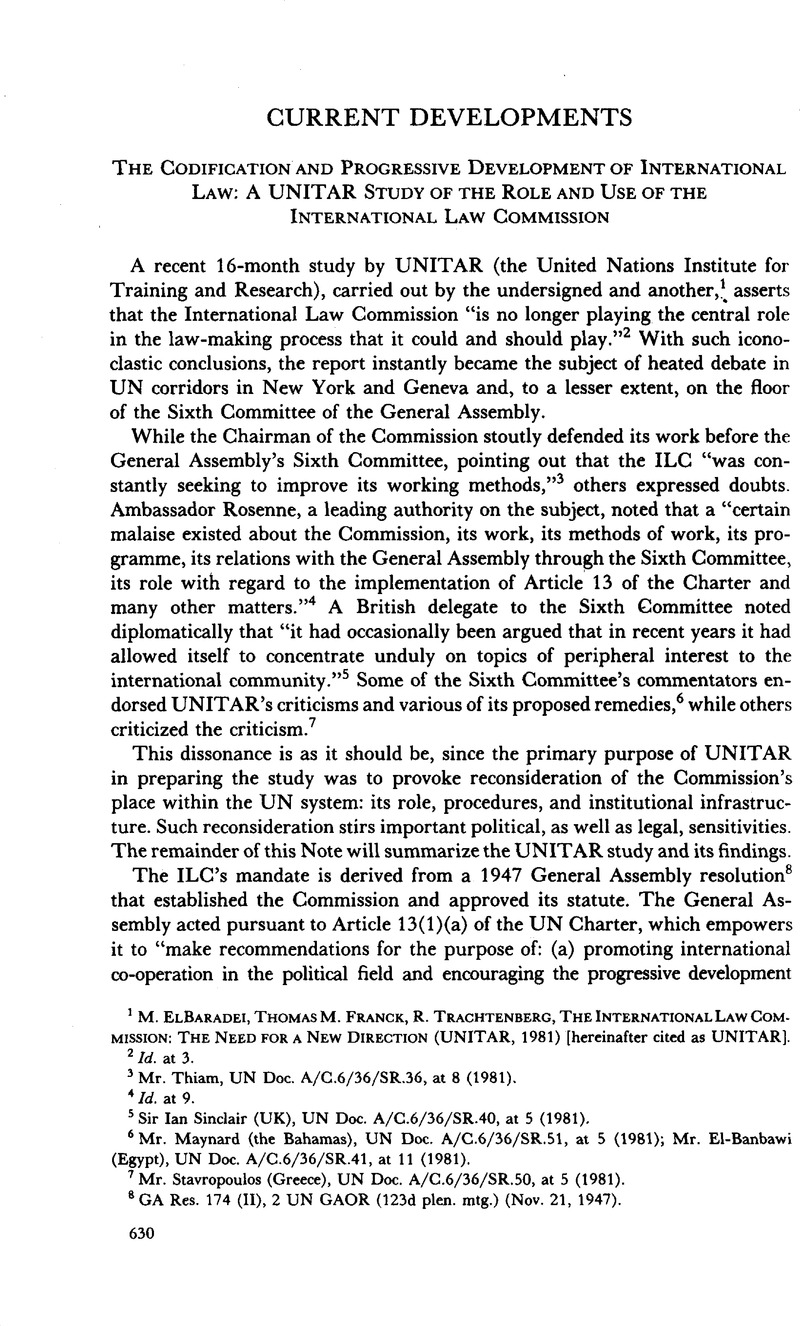Published online by Cambridge University Press: 27 February 2017

1 M. Elbaradei, Thomas M. Franck, R. Trachtenberg, The International Law Commission: The Need For a New Direction (UNITAR, 1981) [hereinafter cited as UNITAR].
2 Id. at 3.
3 Mr. Thiam, UN Doc. A/C.6/36/SR.36, at 8 (1981).
4 Id. at 9.
5 Sir Ian Sinclair (UK), UN Doc. A/C.6/36/SR.40, at 5 (1981).
6 Mr. Maynard (the Bahamas), UN Doc. A/C.6/36/SR.51, at 5 (1981); Mr. El–Banbawi (Egypt), UN Doc. A/C.6/36/SR.41, at 11 (1981).
7 Mr. Stavropoulos (Greece), UN Doc. A/C.6/36/SR.50, at 5 (1981).
8 GA Res. 174 (II), 2 UN GAOR (123d plen. mtg.) (Nov. 21, 1947).
9 Statute of the International Law Commission, Art. I, para. 1.
10 Id., Art. XV.
11 Id., Art. XVII.
12 “The work done by the [International] Court [of Justice], at the judicial level, and that done by the Commission, at the legislative level, are complementary and make those bodies, respectively, the principal judicial and legal organs of the United Nations system.” [1974] 2 Y.B. Int’l L. Comm’n, pt. 1, at 310, para. 208, UN Doc. A/CN.4/SER.A/1974.
13 Review of the Multilateral Treaty-Making Process: Observations of the International Law Commission, UN Doc. A/35/312/Add.2, para. 11 (1980).
14 UNITAR at 5.
15 For a discussion of the distinction between progressive development and codification, see Rosenne, S., The International Law Commission, 1949–59 , 36 Brit. Y.B. Int’l L. 104, 158 (1960)Google Scholar.
16 For the creation of the Ad Hoc Committee, see the discussion in 13 UN GAOR (982d–989th mtgs.), UN Docs. A/C.1/SR.982–89 (1958). See also GA Res. 1348 (XIII), 13 UN GAOR Supp. (No. 18) 5, UN Doc. A/4090 (1958); M. Lachs, The Law of Outer Space (1972).
17 UNITAR at 6. For the creation of the Sea–bed Committee, see GA Res. 2467A (XXIII), 23 UN GAOR Supp. (No. 18) 15, UN Doc. A/7218 (1968); GA Res. 2750 (XXV), 25 UN GAOR Supp. (No. 28) 25, UN Doc. A/8028 (1970). The final report of the Sea–bed Committee is at 28 UN GAOR Supp. (No. 21), UN Doc. A/9021 (1973). For the Ad Hoc Committee on Hostages, see the discussion at 31 UN GAOR (54th, 64th, 69th, and 70th mtgs.), UN Docs. A/C.6/SR.54, 64, 69, and 70 (1977).
18 GA Res. 35/166 (Dec. 15, 1980). For the discussion leading up to this resolution, see 35 UN GAOR, C.6 (68th–75th mtgs.), UN Docs. A/C.6/SR.68–75 (1980).
19 UNITAR at 8–10.
20 UN Doc. A/CN.4/245 (1971), reprinted in [1971] 2 Y.B. Int’l L. Comm’n, pt. 2, at 1–100, UN Doc. A/CN.4/SER.A/1971.
21 [1973] 1 Y.B. Int’l L. Comm’n 161, para. 31, UN Doc. A/CN.4/SER.A/1973 (statement of P. Reuter).
22 Some members who hold this view give the Commission’s work on the definition of aggression as an example of the inadvisability of taking up topics that are politically controversial. After deliberations, the Commission found itself hopelessly split concerning the correct approach to the problem. It reported to the Sixth Committee its decision to abandon efforts to formulate a definition. According to some observers, the Commission’s failure in this instance caused it to be skeptical about taking on projects of a primarily political nature. For the results of the Commission’s discussions and the reactions of the Sixth Committee, see respectively, Report of the International Law Commission covering the work of its third session, 6 UN GAOR Supp. (No. 9) 8–10, UN Doc. A/r858 (1951), and 6 UN GAOR, C.6 (278th–295th mtgs.), UN Docs. A/C.6/SR.278–95 (1951).
23 See Rosenne, supra note 15, at 150–51. Rosenne gives three reasons for the General Assembly’s rejection of the draft on arbitral procedure: (1) the boldness of the Commission’s approach in basing the draft on a concept of judicial instead of diplomatic arbitration, (2) a feeling that the draft relied too heavily on progressive development, and (3) the fact that the political climate of the United Nations was not ready for a further extension of the judicial settlement of disputes in the place of diplomacy.
24 UNITAR at 12.
25 Ibid.
26 UNITAR at 13.
27 Id. at 29.
28 Id. at 15–16.
29 Report of the International Law Commission to the General Assembly, [1951] 2 Y.B. Int’l L. Comm’n 137–39, UN Doc. A/CN.4/SER.A/1951/Add.1.
30 UNITAR at 14. For the South West Africa case, see [1966] ICJ Rep. 6.
31 Ibid.
32 Id. at 20.
33 Ibid.
34 Id. at 24.
35 Id. at 30.
36 Id. at 30–32.
37 Id. at 31.
38 “Model rules” have been used only once. See the Model Rules on Arbitral Procedure, [1958] 2 Y.B. Int’l L. Comm’n 80–88, UN Doc. A/CN.4/SER.A/1958. During the consideration of the topic of nonnavigational uses of international watercourses, some members suggested that the Commission should produce a framework agreement that could be used by two or more states desiring to regulate the uses of a common watercourse. See [1979] 2 Y.B. Int’l L. Comm’n, pt. 2, at 166, UN Doc. A/CN. 4/SER.A/1979. At the 1980 session of the Commission, it was decided to concentrate on drafting a set of articles containing basic rules applicable to international watercourses generally. These articles would be designed to complement more detailed arrangements for particular international watercourses to be negotiated by the states concerned. See Report of the International Law Commission on the work of its 32d session, 35 UN GAOR Supp. (No. 10), UN Doc. A/35/10 (1980).
39 UNITAR at 26–27.
40 Id. at 26.
41 Id. at 17.